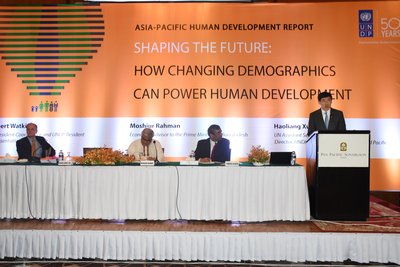BEIJING, April 26, 2016 /PRNewswire/ -- Demographic change in Asia and the Pacific is happening at a rate the world has never seen. An explosion in the working age population and a fall in birth rates that took a century in Europe are happening here in just 30 years.

If countries do not start planning for this demographic transition, they will miss out on a unique opportunity to boost growth and investments for the future, says the United Nations Development Programme (UNDP) in its latest Regional Human Development Report. They also risk a surge in youth frustration, exacerbating instability and conflict.
The Report, entitled "Shaping the Future: How Changing Demographics Can Power Human Development", notes that Asia-Pacific countries now have more working-aged people and fewer dependents than at any point in history, providing a springboard for growth.
"This Asia-Pacific Human Development Report offers the kind of thought leadership that will be essential. It highlights how Asia-Pacific has favourable demographic patterns that provide a historic opportunity to accelerate human development and galvanize progress on the Sustainable Development Goals," said Haoliang Xu, UN Assistant Secretary-General and UNDP Director for Asia and the Pacific.
The report calls for immediate responses and outlines "9 Actions for Sustainable Development". These are concrete policies tailored to the demographic profile of individual countries.
China: job creation key to maximizing the demographic dividend
According to the Report, China's working age population rose from 56 percent of the total population in 1960 to 73 percent in 2015. During this time China also experienced unprecedented economic growth, which can be attributed to many factors, including a large influx of people into the workforce. China skillfully took advantage of this era of surging labour supply by creating a large number of jobs and boosting economic output.
The Report points out that the demographic dividend contributed 15% of the total national GDP. China's economic miracle, from which other countries can learn, shows that job creation is not sufficient for economic growth. It must be accompanied by appropriate economic and social policies to propel poverty reduction and improve human development.
Managing an ageing population is a complex and dynamic process, with challenges and opportunities
Asia-Pacific has the world's largest number of older people, at around 489 million, of whom over 209 million live in China. Among those aged over 60, 23 percent, or 42 million individuals, live below the poverty line. Furthermore, due to an increase in urbanization, many older people in rural areas lack familial support, meaning the needs of the elderly are among one of the greatest challenges for China's future.
China therefore has initiated various social protection measures aimed at universal pension coverage. By 2013 nearly 75 percent of the population aged 15 and above were covered by a pension scheme. China then embarked on a number of reforms for a more equitable, adequate and sustainable pension system for all. This experience shows that if adequate policies are in place, extending pension coverage to all citizens is feasible within a short space of time.
The Report emphasizes the need for countries with ageing populations to improve healthcare systems, support active ageing and promote appreciation for the value of older citizens. This includes making sure that older people who want to work can bring their skills and experience to the market.
Promote more inclusive, compact and greener cities
In China alone, the number of cities with 500,000 to 1 million people rapidly increased from 81 in 2000 to 155 in 2015. These large cities generate 56 percent of total national GDP, and this proportion will reach 75 percent by 2030.
Cities offer improved quality of housing, health systems, education and transport, as well as better opportunities to save money and invest. However, urbanization is not without complex challenges. The massive growth in cities has significantly affected the environment, with an increased need for sustainable development becoming a top priority.
Alongside this China has started to build a low carbon economy and is calling for a new style of people-centered urbanization in its first urbanization policy, which was released in March 2014. Additionally, the government has pledged to spend $280 billion on measures to reduce air pollution over the next five years, while requiring 15,000 factories, including state-owned enterprises, to disclose data on airborne emissions and water discharge.
The Report states that the region needs to promote more inclusive, greener and more compact cities in order to sustain high rates of urbanization. China is already exploring many of these measures.
To download the report, please click here.
UNDP partners with people at all levels of society to help build nations that can withstand crisis, and drive and sustain the kind of growth that improves the quality of life for everyone. On the ground in 177 countries and territories, we offer global perspective and local insight to help empower lives and build resilient nations. www.undp.org
Get in touch:
UNDP on Weibo | Media Contacts
WeChat ID: undpchina
More resources: Our work | UNDP News